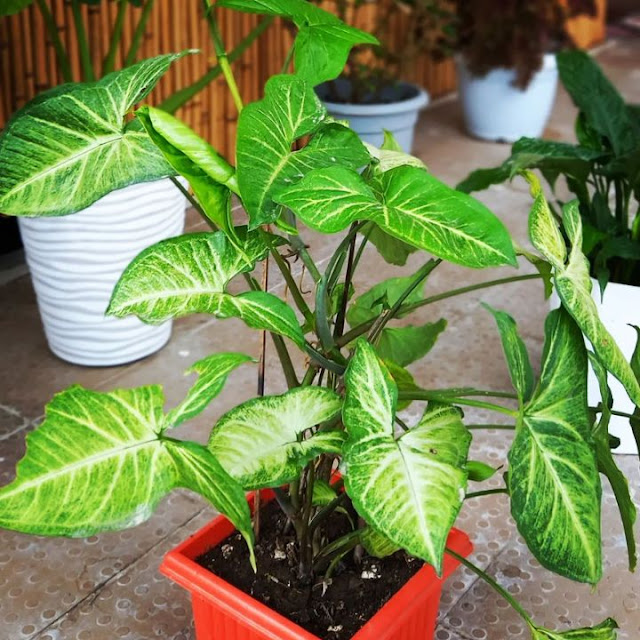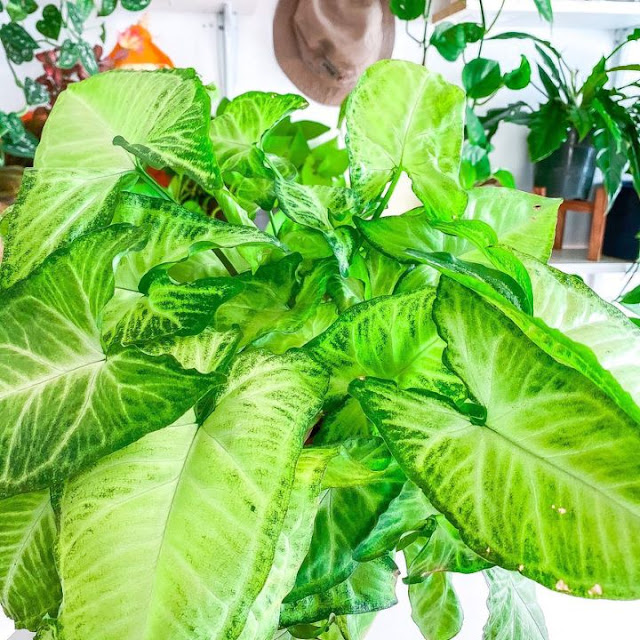Green Nephthytis: A Low-Maintenance Plant
Green Nephthytis, also known as Arrowhead Vine or Syngonium podophyllum, is a popular houseplant known for its lush, green arrow-shaped leaves.It is a member of the Araceae family and is a type of Syngonium, a genus of plants that includes several species of trailing or climbing plants.
Native to the tropical forests of Central and South America, Green Nephthytis is a popular choice for indoor gardens due to its ease of care and attractive foliage
Appearance
Nephthytis is a trailing or climbing plant that can reach up to 2-3 feet in length when grown in ideal conditions.
The leaves are glossy, dark green, and shaped like arrows, giving the plant its common name.
As the plant matures, the leaves may become larger and more lobed.
Nephthytis does not produce flowers or fruit when grown as a houseplant.
Light and Temperature
Nephthytis prefers bright, indirect light and can tolerate lower light conditions but will grow slower and may lose some of its vibrant green colors.
The ideal temperature range is between 60-85°F (15-29°C).
Soil and Watering
Nephthytis prefers evenly moist, well-draining soil.
It's important not to over-water, as the plant can suffer from root rot if the soil is too wet.
Allow the top inch of soil to dry out before watering again.
Propagation
Nephthytis can be easily propagated by rooting stem cuttings in water or soil.
It is also possible to propagate Nephthytis by dividing the root ball of an established plant.
Pest and Diseases
Nephthytis is relatively pest-free but susceptible to spider mites, mealybugs, and scale insects.
Overwatering can lead to root rot, a common problem with this plant.
Overall, Green Nephthytis is an excellent option for indoor gardens due to its ease of care and attractive foliage. With proper care, it can thrive for many years and add a touch of green to any room.
Caring for Green Nephthytis
Light:
Nephthytis prefers bright, indirect light and can tolerate lower light conditions but will grow slower and may lose some of its vibrant green colors.
Temperature:
The ideal temperature range is between 60-85°F (15-29°C).
Soil:
Nephthytis prefers evenly moist, well-draining soil.
Watering:
It's important not to over-water, as the plant can suffer from root rot if the soil is too wet. Allow the top inch of soil to dry out before watering again.
Propagation:
Nephthytis can be easily propagated by rooting stem cuttings in water or soil. It is also possible to multiply Nephthytis by dividing the root ball of an established plant.
Pest and Diseases: Nephthytis is relatively pest-free but susceptible to spider mites, mealybugs, and scale insects. Overwatering can lead to root rot, a common problem with this plant.
Growing Green Nephthytis
Green Nephthytis is a trailing or climbing plant that can reach up to 2-3 feet in length when grown in ideal conditions.
To encourage the plant to climb, provide it with a trellis or other support structure.
Nephthytis does not produce flowers or fruit when grown as a houseplant.
Here are some interesting facts about Green Nephthytis:
The genus name "Syngonium" comes from the Greek words "syn," meaning "together," and "genius," meaning "joint," referring to the way the stem and petiole are fused in the leaf structure.
In its native habitat, Nephthytis is a climbing vine that can reach up to 30 feet in length, but when grown as a houseplant, it is often kept more diminutive and more compact.
The arrow-shaped leaves of Nephthytis are unique among plants in the Araceae family, which typically have more rounded or heart-shaped leaves.
Nephthytis is also known as the "Five Fingers" in some parts of the world because the leaves resemble the fingers on a hand.
Some indigenous people in Central and South America have used Nephthytis medicinally to treat various ailments, including fever and stomach problems.
The Nephthytis is also considered an excellent indoor plant for air purification.
"Please note that some of these facts may not be scientifically proven, and the use of Nephthytis for medicinal purposes should always be consulted with a qualified healthcare professional"
FAQs
Q: Can Green Nephthytis be grown outdoors?
Green Nephthytis can be grown outdoors in tropical climates, but it is generally grown as a houseplant in other regions.
Q: How often should I water Nephthytis?
Allow the top inch of soil to dry out before watering again. Be careful not to overwater, as this can lead to root rot.
Q: Can I propagate Nephthytis from a single leaf?
No, Nephthytis can only be propagated from stem cuttings or by dividing the root ball of an established plant.
Q: How can I tell if my Nephthytis is getting enough light?
If the leaves of your Nephthytis are turning yellow or pale, it may not be getting enough light. Move the plant to a brighter location and monitor the foliage for improvement.
Learn More about Syngonium Pink Plants and their types.






Comments
Post a Comment